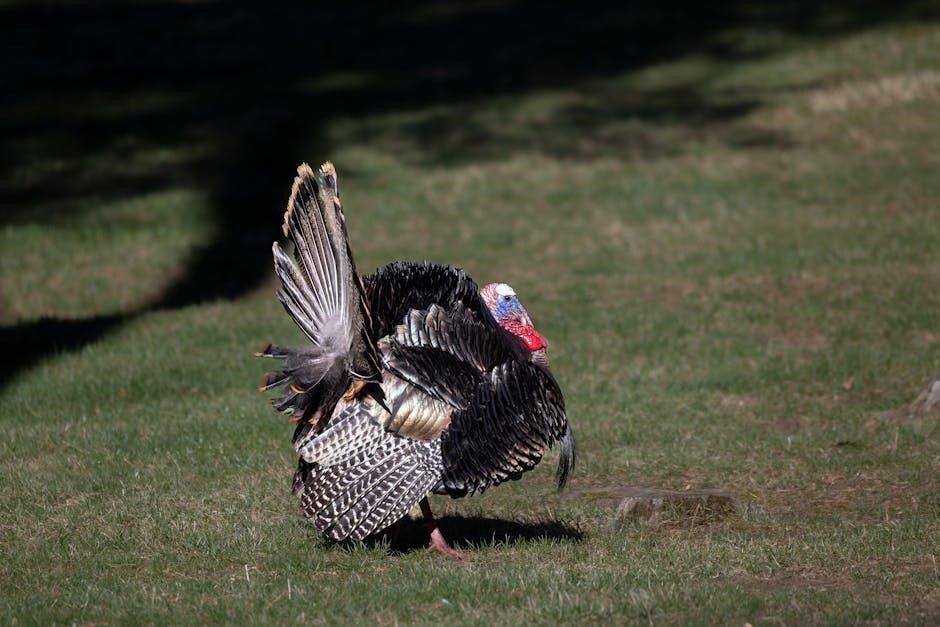
“The Conference of the Birds” is a timeless Sufi allegory by Farid ud-Din Attar, exploring themes of spirituality, unity, and self-discovery through the journey of birds seeking the Simurgh.
1.1 Background and Historical Context
“The Conference of the Birds”, written by Farid ud-Din Attar in the 12th century, is a revered Persian poem rooted in Sufi mysticism. It reflects the spiritual and cultural milieu of its time, blending allegory with profound philosophical insights. The poem’s historical significance lies in its exploration of human spirituality, making it a cornerstone of Persian literature and a timeless inspiration for seekers of truth.
1.2 Significance of the Title “Conference of the Birds”
The title reflects a gathering of birds, symbolizing unity and diversity, each bird representing a human archetype. The “Conference” signifies a collective spiritual journey toward self-discovery and divine truth, embodying the essence of Sufi teachings and universal human experiences, making it a profound and enduring metaphor in world literature.
The Author and His Vision
Farid ud-Din Attar, a renowned Persian poet, crafted “The Conference of the Birds” as an allegory of the soul’s journey to divine truth, emphasizing unity and love.
2.1 Farid ud-Din Attar: A Brief Biography
Farid ud-Din Attar, a revered Persian poet and Sufi mystic, was born in Nishapur around 1142 AD. His works, including “The Conference of the Birds,” reflect deep spiritual insight, blending themes of love, unity, and the pursuit of divine truth, leaving an enduring legacy in Persian literature and Sufi tradition.
2.2 The Spiritual and Philosophical Themes in His Work
Attar’s work delves into Sufi mysticism, emphasizing divine love, self-discovery, and spiritual purification. His poetry explores themes of unity, sacrifice, and the annihilation of the ego, guiding seekers toward divine truth. Through allegories and fables, he conveys the essence of mystical experiences, reflecting the depth of Sufi philosophy and its transformative power on the human soul.
Main Themes of the Poem
“The Conference of the Birds” explores profound themes of spiritual enlightenment, divine unity, and existential purpose, using the birds’ journey as a metaphor for humanity’s quest for truth and self-discovery.
3.1 The Quest for Truth and Spiritual Enlightenment
The birds’ journey symbolizes the human pursuit of divine truth, highlighting the challenges and sacrifices required for spiritual awakening. Attar’s narrative emphasizes self-reflection, perseverance, and the transcendence of ego, guiding seekers through stages of enlightenment to attain union with the divine, reflecting Sufi mysticism’s core principles of inner purification and love-driven spirituality.
3.2 The Concept of Love and Unity
Love and unity are central themes, as the birds’ collective journey embodies the power of cohesion and shared purpose. Attar illustrates that true unity arises from selfless love, dissolving individual Differences and guiding souls toward the divine, symbolized by the Simurgh, reflecting Sufi ideals of universal harmony and the healing power of love.
3.3 The Journey of the Birds as a Metaphor for Human Existence
The birds’ quest mirrors human existence, symbolizing the search for meaning and truth. Each bird represents a unique aspect of the human condition, with their struggles and perseverance reflecting the universal journey toward self-discovery and enlightenment. The narrative underscores the resilience needed to navigate life’s challenges and the ultimate pursuit of spiritual fulfillment.

Symbolism in “The Conference of the Birds”
The poem richly employs symbolism, with birds representing human souls and their diverse qualities. The Simurgh embodies divine truth, while the journey reflects spiritual purification and unity, guiding readers to self-discovery.
4.1 The Bird Kingdom as a Symbol of Humanity
The bird kingdom in the poem mirrors human society, with each bird representing diverse traits, struggles, and aspirations. Their collective journey symbolizes humanity’s quest for truth, unity, and self-discovery, reflecting the complexities and diversity of human nature through relatable avian characters and their unique perspectives.
4.2 The Role of the Hoopoe and Other Birds in the Narrative
The Hoopoe, as the leader, initiates the journey, symbolizing wisdom and divine guidance. Each bird represents unique human traits, with their debates and interactions reflecting spiritual and existential struggles. Their diverse personalities and flaws enrich the allegory, while their collective quest underscores unity and shared human experiences in the pursuit of truth and enlightenment.
4.3 The Significance of the Simurgh
The Simurgh symbolizes divine truth and self-discovery, embodying unity and transcendence. The birds’ journey culminates in the realization that the Simurgh is not an external deity but the essence of their collective soul, mirroring Sufi ideals of finding God within oneself and understanding true identity through spiritual awakening and self-reflection.
Philosophical and Mystical Interpretations
Farid ud-Din Attar’s masterpiece delves into Sufi mysticism, exploring themes of self-discovery, divine love, and spiritual unity. The birds’ journey reflects the soul’s quest for enlightenment and connection with the divine.
5.1 Sufi Mysticism and Its Influence on the Poem
Farid ud-Din Attar’s The Conference of the Birds is deeply rooted in Sufi mysticism, emphasizing themes of divine love, self-discovery, and spiritual purification. The poem’s allegorical journey of birds seeking the Simurgh reflects the Sufi path to unity with the divine, echoing the mystical traditions of love, devotion, and inner transformation central to Sufi teachings.
5.2 The Concept of Self-Discovery and Inner Transformation
The Conference of the Birds explores self-discovery through the allegorical journey of birds seeking the Simurgh. Each bird’s challenges and realizations symbolize the human quest for spiritual growth. The poem underscores the necessity of introspection, humility, and perseverance, ultimately revealing that true transformation lies in understanding one’s essence and unity with the divine, beyond ego and material attachments.
5.3 The Role of Love in Sufi Philosophy
Love is central to Sufi philosophy, depicted in The Conference of the Birds as the driving force behind the birds’ quest for the Simurgh. It symbolizes a profound, selfless devotion, transcending earthly desires. Through love, the soul seeks union with the divine, mirroring the birds’ ultimate realization that true fulfillment lies in unconditional love and spiritual harmony.

The Structure and Style of the Poem
The Conference of the Birds, a Persian allegorical poem, features lyrical and mystical language. Its structure, divided into stages, uses fables and poetic devices to explore Sufi themes deeply.
6.1 The Use of Allegory and Fable
Attar’s allegorical masterpiece employs fables to convey profound spiritual truths. The birds’ journey symbolizes the human soul’s quest for enlightenment, with each species representing distinct human traits. The hoopoe, as a guide, embodies wisdom, while the Simurgh signifies the divine. This structure allows universal themes to resonate deeply, blending moral lessons with mystical insights.
6.2 The Poetic Devices and Literary Techniques Employed
Attar enriches the narrative with rhyme, metaphor, and symbolism, creating vivid imagery. Repetition emphasizes key themes, while personification breathes life into birds, mirroring human emotions. The interplay of poetic devices enhances the mystical atmosphere, drawing readers into the spiritual journey and deepening the emotional and philosophical impact of the tale.
6.3 The Language and Rhythm of the Verse
The poem’s language is lyrical and expressive, rooted in Persian poetic traditions. Attar employs a consistent meter and rhyme scheme, creating a rhythmic flow that enhances the narrative’s musicality. This rhythmic structure not only aids in memorization but also deepens the meditative quality of the text, making it a powerful tool for spiritual reflection and contemplation.

Characters and Their Roles
The Conference of the Birds features a diverse cast of bird characters, each representing unique human traits and spiritual struggles. Their roles illustrate universal themes of faith, perseverance, and self-discovery.
7.1 The Hoopoe as the Leader and Guide
The Hoopoe serves as the wise leader and guide of the bird kingdom, initiating the quest for the Simurgh. With his profound knowledge and spiritual insight, he inspires the birds to embark on their journey, overcoming their fears and doubts. His guidance embodies the Sufi ideals of wisdom, perseverance, and divine love, making him a central figure in the narrative.
7.2 The Nightingale and Its Symbolism
The Nightingale, with its enchanting song, symbolizes the soul’s longing for divine love and connection. Its beautiful voice represents the human heart’s yearning for spiritual truth, while its persistent singing despite challenges mirrors the Sufi path of relentless pursuit of enlightenment and unity with the Beloved, reflecting both passion and devotion in the spiritual journey.
7.3 The Falcon and the Parrot: Contrasting Perspectives
The Falcon and the Parrot symbolize contrasting attitudes in “The Conference of the Birds.” The Falcon, with its majesty and confidence, represents clarity and focus, while the Parrot, often trapped in imitation, embodies superficiality. Their differing perspectives highlight the diversity of seekers on the spiritual path, emphasizing the need to transcend external appearances and embrace inner truth for genuine enlightenment.

The Journey and Its Stages
The Conference of the Birds unfolds as a profound spiritual journey, divided into stages that symbolize purification, self-discovery, and ultimate union with the divine, reflecting human existence’s deeper truths.
8.1 The Seven Valleys: A Representation of Spiritual Stages
The Seven Valleys in The Conference of the Birds symbolize the stages of spiritual growth, each representing a unique challenge and lesson for the birds on their quest to find the Simurgh. They journey through valleys of Quest, Love, Knowledge, Detachment, Unity, Bewilderment, and Poverty, each stage refining their souls and deepening their understanding of the divine.
8.2 The Trials and Challenges Faced by the Birds
The birds endure numerous trials and challenges on their arduous journey to the Simurgh, each testing their resolve, courage, and understanding. From navigating treacherous landscapes to confronting existential questions, these trials symbolize the human struggle with doubt, fear, and attachment. Each challenge refines their souls, preparing them for the ultimate realization of divine unity and truth.
8.3 The Ultimate Realization and Union with the Simurgh
The birds finally reach the Simurgh, experiencing a profound realization. Only thirty remain, discovering their true selves and understanding they are the Simurgh. This union dissolves individual identities, revealing ultimate reality. Their journey concludes in unity, reflecting the essence of Sufi mysticism and its timeless message of divine truth and self-discovery.
Cultural and Historical Impact
“The Conference of the Birds” has profoundly influenced Persian literature and spirituality. Its themes of unity and love resonated globally, making it a cornerstone of Sufi tradition and teachings.
9.1 The Influence of “The Conference of the Birds” on Persian Literature
“The Conference of the Birds” is a masterpiece of Persian literature, inspiring countless poets and writers. Its allegorical style and themes of spiritual quest and self-discovery have shaped Persian poetry, influencing later Sufi writers and remaining a cornerstone of the region’s literary heritage.
9.2 Its Reception and Translation in Other Cultures
“The Conference of the Birds” has been widely translated and admired across cultures. Its universal themes of unity and love resonate globally, making it a cherished text in many languages, including English, French, and Turkish. This cross-cultural appeal highlights its enduring relevance and ability to transcend linguistic and cultural boundaries.
9.3 The Poem’s Role in Sufi Tradition and Teachings
“The Conference of the Birds” is a cornerstone of Sufi literature, illustrating spiritual journeys and divine love. It uses allegorical narratives to convey Sufi teachings, emphasizing self-discovery and unity with the divine. The poem’s profound mysticism continues to inspire Sufi followers, making it a vital text in their spiritual practice and philosophical reflection.
Modern Relevance and Interpretations
“The Conference of the Birds” remains a powerful allegory for modern spirituality, offering insights into love, unity, and self-discovery. Its universal themes resonate with contemporary seekers of meaning and connection.
10.1 The Timeless Message of Unity and Love
The Conference of the Birds conveys a universal message of unity and love, transcending time and culture. Attar’s allegory highlights the importance of collective journey and harmony, emphasizing that true enlightenment arises from embracing love and interconnectedness, making it a cherished text for modern spiritual and philosophical discussions.
10.2 The Poem’s Appeal to Contemporary Readers
The Conference of the Birds resonates deeply with modern readers, offering insights into self-reflection and existential questions. Its themes of perseverance, diversity, and the quest for meaning align with contemporary concerns, making Attar’s masterpiece a relevant and inspiring read in today’s globalized and spiritually seeking world.
10.3 Its Use in Modern Spirituality and Self-Help
The Conference of the Birds is widely used in modern spirituality and self-help, offering timeless wisdom on self-discovery and inner transformation. Its themes of perseverance, unity, and divine connection resonate with contemporary seekers, making it a cherished resource for personal growth and mindfulness in an increasingly complex world.
Challenges in Interpreting the Poem
Interpreting “The Conference of the Birds” poses challenges due to its dense Sufi symbolism and poetic nuances, requiring deep cultural and mystical understanding to unravel its profound meanings.
11.1 The Complexity of Sufi Symbolism
The poem’s Sufi symbolism is intricate, with layered meanings that require deep cultural and mystical understanding. The birds, valleys, and Simurgh represent abstract spiritual concepts, making interpretation challenging without expertise in Sufi traditions and Persian mysticism. The allegorical language adds complexity, as symbols often carry multiple interpretations, demanding a nuanced approach to unravel their profound significance.
11.2 The Difficulty in Translating the Poem’s Depth
Translating “The Conference of the Birds” is challenging due to its lyrical richness and cultural nuances. The poem’s depth, embedded with mystical themes, often loses its emotional resonance in translation. Conveying Attar’s layered symbolism and poetic subtleties requires careful linguistic adaptation, ensuring the essence of the original Persian text is preserved for English readers.
11.3 The Diverse Interpretations and Controversies
“The Conference of the Birds” has sparked diverse interpretations, with debates over its mystical versus literal meanings. Its Sufi themes and philosophical depth often lead to varying analyses, while its universal message of unity and self-discovery continues to resonate, though translations and cultural perspectives may influence its understanding and reception across different audiences and traditions.
“The Conference of the Birds” leaves a lasting legacy, offering timeless wisdom on unity, love, and self-discovery, resonating universally across cultures and centuries.
12.1 The Enduring Legacy of “The Conference of the Birds”
“The Conference of the Birds” has left an indelible mark on literature and spirituality, inspiring countless readers with its profound themes of unity, love, and self-discovery. Its influence transcends time and culture, making it a cherished text in both Sufi tradition and global literary heritage, continuing to resonate deeply with modern audiences seeking spiritual guidance and universal truths.
12.2 The Universal Message of the Poem
“The Conference of the Birds” delivers a universal message of unity, love, and the pursuit of truth, transcending cultural and temporal boundaries. Its themes of self-discovery and the quest for meaning resonate deeply, offering timeless wisdom that continues to inspire readers worldwide, making it a profound and enduring work of spiritual and literary significance.
12.3 The Continued Relevance in Today’s World
“The Conference of the Birds” remains remarkably relevant today, offering insights into universal human struggles and aspirations. Its themes of unity, self-discovery, and the pursuit of truth resonate in modern contexts, providing guidance for personal growth, mindfulness, and spiritual exploration in an increasingly complex and interconnected world.